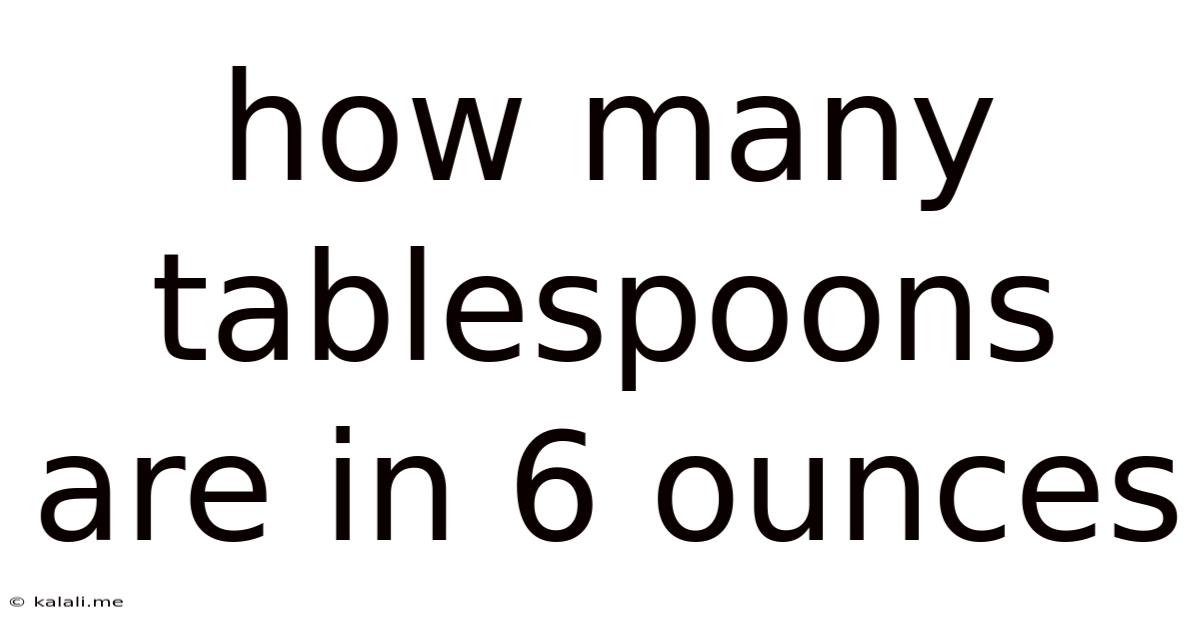How Many Tablespoons Are In 6 Ounces
Kalali
Jun 30, 2025 · 4 min read

Table of Contents
How Many Tablespoons Are in 6 Ounces? A Comprehensive Guide to Volume Conversions
This seemingly simple question, "How many tablespoons are in 6 ounces?", actually opens the door to a fascinating world of culinary conversions and measurement precision. While a quick online search might give you a straightforward answer, understanding the nuances behind this conversion is crucial for anyone who cooks, bakes, or works with recipes regularly. This comprehensive guide dives deep into the intricacies of volume conversions, exploring the relationship between ounces, tablespoons, and other common units, providing you with the knowledge to confidently tackle any recipe or measurement challenge.
Understanding the Units: Ounces and Tablespoons
Before we delve into the conversion, let's define our terms. We're dealing with two different units of volume:
-
Ounces (oz): A unit of weight in the imperial and US customary systems. Crucially, in the context of cooking and baking, we're often referring to fluid ounces, which measure volume. One fluid ounce is approximately 29.57 milliliters.
-
Tablespoons (tbsp or T): A unit of volume, typically used in cooking and baking recipes. A tablespoon is a commonly used measuring utensil in many kitchens.
The Conversion: 6 Ounces to Tablespoons
The simple answer is that there are approximately 6 tablespoons in 1 fluid ounce. Therefore, 6 fluid ounces contains approximately 36 tablespoons (6 oz * 6 tbsp/oz = 36 tbsp).
However, this is a simplified conversion. The exact number can vary slightly depending on the substance being measured. The density of liquids and ingredients can affect their volume. For instance, a fluid ounce of water will have a slightly different weight than a fluid ounce of oil.
Factors Affecting Accuracy: Density and Viscosity
The accuracy of this conversion hinges on the density of the substance being measured. Denser substances will have more mass per unit volume. Consider these examples:
-
Water: Water is relatively dense and consistent, making the 6 tablespoons per fluid ounce conversion quite accurate.
-
Oil: Oil is less dense than water, meaning a fluid ounce of oil will have fewer tablespoons compared to water.
-
Honey: Honey is even denser and more viscous than water, requiring a slight adjustment to the conversion factor.
-
Flour: Flour is a dry ingredient, and its volume can vary significantly depending on how it's packed. Therefore, using volume measurements for flour is generally less precise than using weight measurements (grams or ounces).
Beyond Tablespoons: Exploring Other Volume Units
Understanding the relationship between ounces and tablespoons is only one piece of the puzzle. Accurate cooking and baking rely on familiarity with other volume units. Let's explore some key conversions:
-
Ounces to Milliliters (ml): 1 fluid ounce is approximately equal to 29.57 milliliters.
-
Tablespoons to Milliliters (ml): 1 tablespoon is approximately equal to 14.78 milliliters.
-
Tablespoons to Teaspoons (tsp): 1 tablespoon is equal to 3 teaspoons.
-
Cups to Ounces: 1 cup is equal to 8 fluid ounces.
Practical Applications and Tips for Accurate Measurement
Precise measurement is essential for consistent results in cooking and baking. Here are some practical tips:
-
Use accurate measuring tools: Invest in a good set of measuring cups and spoons. Avoid using casual household items like mugs or spoons that are not standardized.
-
Level off dry ingredients: When measuring dry ingredients like flour or sugar, use a straight edge to level the top of the measuring cup, ensuring accurate volume.
-
Understand the limitations of volume measurements: For ingredients that are highly variable in density, consider weighing them using a kitchen scale for more precise measurements.
-
Use the correct type of ounce: Always ensure you are using fluid ounces (fl oz) when dealing with liquid volumes.
Advanced Considerations: Specific Gravity and Density
For truly precise measurements, especially in scientific or industrial applications, understanding specific gravity and density becomes essential. Specific gravity compares the density of a substance to the density of water. A specific gravity of 1 indicates the substance has the same density as water. A specific gravity greater than 1 indicates a denser substance, while a specific gravity less than 1 indicates a less dense substance.
Conclusion: Mastering Volume Conversions for Culinary Success
While the simple conversion of 6 ounces to approximately 36 tablespoons is a useful starting point, achieving truly accurate measurements requires a deeper understanding of the factors influencing volume. By accounting for density, viscosity, and employing precise measuring tools, you can elevate your cooking and baking skills, producing consistent and delicious results every time. Remember to always prioritize accuracy and consider the limitations of volume-based measurements for certain ingredients. Mastering these conversions will transform you into a more confident and skilled cook or baker. This knowledge extends beyond the kitchen, proving valuable in various fields where precise volume measurement is critical.
Latest Posts
Latest Posts
-
How Long Will It Take To Walk 20 Miles
Jun 30, 2025
-
What Do You Call Drawing Squares On Dracula
Jun 30, 2025
-
Do Brad Pitts Twins Have Down Syndrome
Jun 30, 2025
-
The Value Does Not Match The Pattern A
Jun 30, 2025
-
How Many Gallons Are In 8 Quarts
Jun 30, 2025
Related Post
Thank you for visiting our website which covers about How Many Tablespoons Are In 6 Ounces . We hope the information provided has been useful to you. Feel free to contact us if you have any questions or need further assistance. See you next time and don't miss to bookmark.